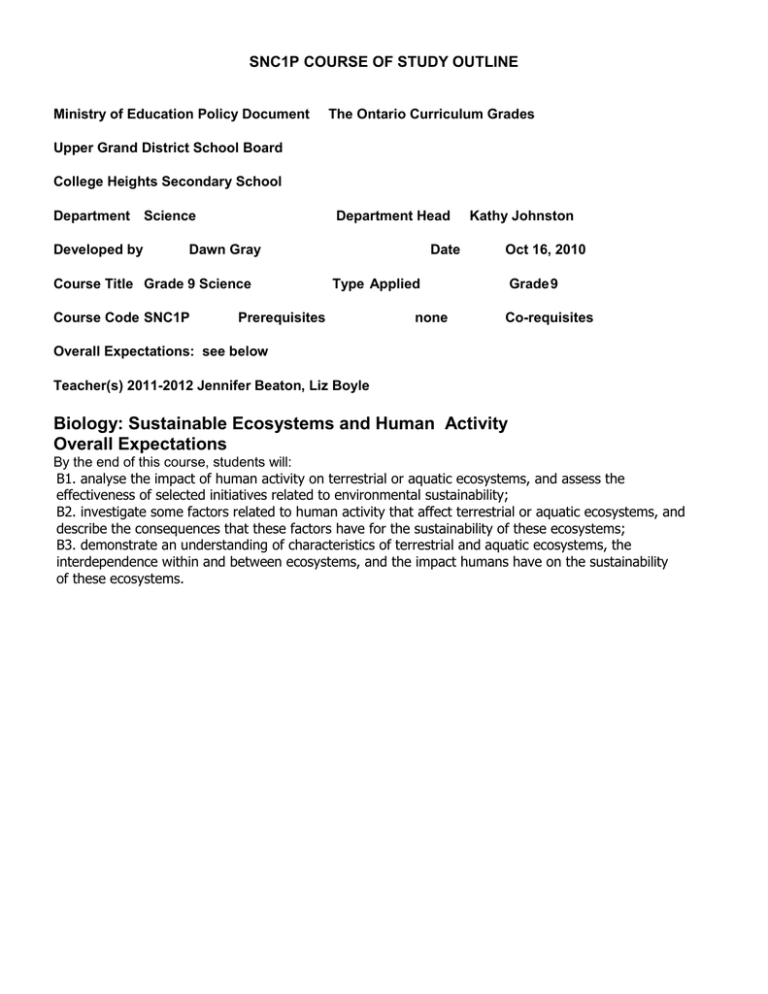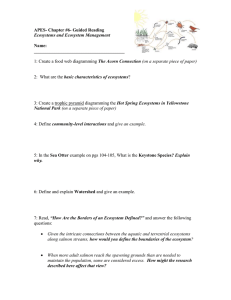SNC1P COURSE OF STUDY OUTLINE
advertisement

SNC1P COURSE OF STUDY OUTLINE Ministry of Education Policy Document The Ontario Curriculum Grades Upper Grand District School Board College Heights Secondary School Department Science Developed by Department Head Dawn Gray Course Title Grade 9 Science Course Code SNC1P Date Kathy Johnston Oct 16, 2010 Type Applied Prerequisites none Grade 9 Co-requisites Overall Expectations: see below Teacher(s) 2011-2012 Jennifer Beaton, Liz Boyle Biology: Sustainable Ecosystems and Human Activity Overall Expectations By the end of this course, students will: B1. analyse the impact of human activity on terrestrial or aquatic ecosystems, and assess the effectiveness of selected initiatives related to environmental sustainability; B2. investigate some factors related to human activity that affect terrestrial or aquatic ecosystems, and describe the consequences that these factors have for the sustainability of these ecosystems; B3. demonstrate an understanding of characteristics of terrestrial and aquatic ecosystems, the interdependence within and between ecosystems, and the impact humans have on the sustainability of these ecosystems. B1. Relating Science to Technology, . Strands - Titles and Times 1 Relating Science to Technology, Society, and the Environment hours 2 Developing Skills of Investigation and Communication hours 3 Understanding Basic Concepts hours Accommodations: preferential seating, quiet classroom environment / alternate setting, flexible time lines, variety in daily work, hands on activities, reduce written output, reduced text on assignments and worksheets, daily literacy activity, uncluttered format/ chunking, open book Formative Assessment: daily observations, worksheets, class discussion, games, „check-in‟ Unit Evaluation: 40% Knowledge 10% Thinking 10% Communication 40% Application Final Evaluation: Term work: 70 % (Daily: 25%; Projects 30%: Quizzes and Tests 45%) Final exam: 30% (50% Written Exam; 50% Culminating Task) STRAND B1. Relating Science to Technology, Society, and the Environment Activity Name “Mammals in Decline” article and questions Environmental issue research poster Scenarios: look at project from different perspectives; present point of view Specific Expectations Category B1.1 • analyse, on the basis of research, how a human activity (e.g., urban sprawl, use of pesticides and fertilizers, creation of pollution, human interaction with wildlife) threatens the sustainability of a terrestrial or aquatic ecosystem [IP, PR, AI, C] B1.2 assess the effectiveness of a local initiative of personal interest that seeks to ensure the sustainability of a terrestrial or aquatic ecosystem (e.g., greening their school grounds; conservation efforts of local Aboriginal communities; naturalizing banks of local rivers or ponds with native vegetation; adoption of an integrated pest management strategy to combat pests in a local garden), and explain why the initiative is important to the sustainability of the ecosystem [AI, C] Focus Marks Human impact on local ecosystems 15 Rubric 100% Local initiatives / projects to remediate human impact (We can make a difference) Rubric 100% B2. Developing Skills of Investigation STRAND B2. Developing Skills of Investigation and Communication Activity Name Quiz “Build a Food Web” assignment Summative Test “Migration headaches” activity and/or “Predator/Prey Graph” Research poster with B1.1 Research poster with B1.1 Quiz Specific Expectations B2.1 use appropriate terminology related to sustainable ecosystems and human activity, including, but not limited to: biodiversity, biotic, ecosystem, equilibrium, species diversity, sustainability, and watershed [C] B2.2 investigate the characteristics and interactions of biotic and abiotic components of a terrestrial or aquatic ecosystem, and describe the importance of these components in a sustainable ecosystem [PR, AI, C] B2.3 compile and graph qualitative and quantitative data on organisms within an undisturbed or disturbed ecosystem (terrestrial or aquatic) (e.g., nematode and earthworm populations in soil or compost; bird populations during migration or winter feeding; tadpole and mosquito larvae populations in a local pond) [PR, AI, C] B2.4 plan and conduct an inquiry into how a factor related to human activity affects a terrestrial or aquatic ecosystem (e.g., how changes to soil composition from the use of different compostable materials or organic or inorganic fertilizers affect the types of plants that can be grown; how lower water levels resulting from water diversion affect waterfowl nesting areas and fish reproduction), and describe the consequences that this factor has for the sustainability of the ecosystem [IP, PR, AI, C] B2.5 analyse the effect of factors related to human activity on terrestrial or aquatic ecosystems by interpreting data and generating graphs (e.g., data on the concentration in water of chemicals from fertilizer run-off and their effect on the growth of algae) [AI, C] STRAND B3. Understanding Basic Concepts Category Focus Marks Ecosystem is a dynamic interaction between biotic and abiotic; interactions are in balance; we collect data to understand ecosystem health and human impact on ecosystems Weight 1 10 Weight 2 Rubric 15 Weight 1 Activity Name Summative Test Specific Expectations B3.1 identify similarities and differences between terrestrial and aquatic ecosystems, and describe these similarities and differences using diagrams B3.2 describe the interdependence of the components within a terrestrial and an aquatic ecosystem, and explain how the components of both systems work together to ensure the sustainability of a larger ecosystem B3.3 describe the complementary processes of cellular respiration and photosynthesis with respect to the flow of energy and the cycling of matter within ecosystems (e.g., carbon dioxide is a by-product of cellular respiration and is used for photosynthesis, which produces oxygen needed for cellular respiration), and explain how human activities can disrupt the balance achieved by these processes (e.g., automobile use increases the amount of carbon dioxide in the atmosphere; planting trees reduces the amount of carbon dioxide in the atmosphere) B3.4 identify the major limiting factors of ecosystems (e.g., nutrients, space, water, predators), and explain how these factors are related to the carrying capacity of an ecosystem (e.g., how an increase in the moose population in an ecosystem affects the wolf population in the same ecosystem) B3.5 identify some factors related to human activity that have an impact on ecosystems (e.g., the use of fertilizers and pesticides; altered shorelines; organic and conventional farming; urban sprawl), and explain how these factors affect the equilibrium and survival of populations in terrestrial and aquatic ecosystems (e.g., fertilizers change the fertility of soil, affecting what types of plants can grow in it; pesticides leach into water systems, affecting water quality and aquatic life; shoreline development affects the types of aquatic life and terrestrial vegetation that can live by lake shores or river banks; urban sprawl wipes out fields and woods, destroying wildlife habitats) Categori es Focus Understanding of mechanics of ecosystems in terms of energy flow, nutrient cycles Understanding of how human activity can impact on nutrient cycles Marks Out of Weight 2







